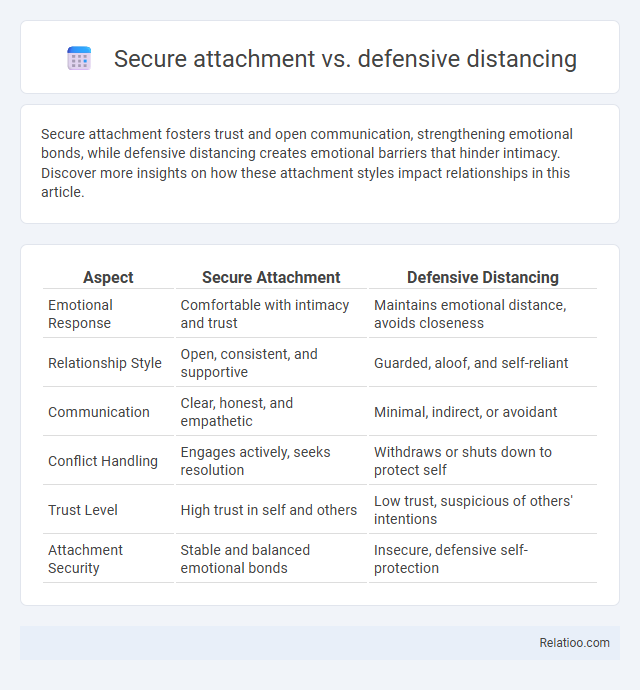Secure attachment fosters trust and open communication, strengthening emotional bonds, while defensive distancing creates emotional barriers that hinder intimacy. Discover more insights on how these attachment styles impact relationships in this article.
Table of Comparison
| Aspect | Secure Attachment | Defensive Distancing |
|---|---|---|
| Emotional Response | Comfortable with intimacy and trust | Maintains emotional distance, avoids closeness |
| Relationship Style | Open, consistent, and supportive | Guarded, aloof, and self-reliant |
| Communication | Clear, honest, and empathetic | Minimal, indirect, or avoidant |
| Conflict Handling | Engages actively, seeks resolution | Withdraws or shuts down to protect self |
| Trust Level | High trust in self and others | Low trust, suspicious of others' intentions |
| Attachment Security | Stable and balanced emotional bonds | Insecure, defensive self-protection |
Understanding Secure Attachment
Secure attachment fosters healthy emotional bonds characterized by trust, intimacy, and effective communication, promoting psychological well-being and resilience. Defensive distancing, by contrast, involves emotional withdrawal and avoidance as a protective mechanism against perceived threats or emotional pain, often leading to strained relationships. Understanding secure attachment requires recognizing its role in enabling emotional security and connection, which contrasts sharply with the isolation and guarded behaviors seen in defensive distancing.
What Is Defensive Distancing?
Defensive distancing is a coping mechanism where individuals emotionally withdraw from others to avoid vulnerability and potential rejection, often triggered by past relational trauma or insecurity. Unlike secure attachment, which fosters trust and open emotional connection, defensive distancing creates barriers that hinder intimacy and increase relational conflict. This behavior manifests as avoidance, reduced communication, and reluctance to engage deeply, ultimately undermining relationship stability and personal well-being.
Key Differences: Secure Attachment vs Defensive Distancing
Secure attachment is characterized by trust, emotional closeness, and effective communication, enabling Your relationships to thrive through mutual support and vulnerability. Defensive distancing involves emotional withdrawal and avoidance of intimacy as a protective mechanism against potential hurt or rejection. Key differences lie in the approach to connection: secure attachment fosters open engagement and resilience, while defensive distancing emphasizes self-protection through detachment and emotional barriers.
Psychological Roots of Attachment Styles
Secure attachment develops from consistent, responsive caregiving that fosters trust and emotional safety, allowing individuals to form healthy, intimate relationships. Defensive distancing arises as a protective mechanism rooted in early experiences of neglect or rejection, causing emotional withdrawal to avoid potential harm. This avoidant attachment style is characterized by suppressed needs for closeness and difficulty in expressing vulnerability due to unresolved fears of abandonment or emotional unavailability.
Signs of Secure Attachment in Relationships
Secure attachment in relationships is characterized by trust, open communication, and emotional availability, allowing you to feel safe and supported. Signs include comfort with intimacy, the ability to express needs without fear, and consistent responsiveness to your partner's emotions. In contrast, defensive distancing manifests as emotional withdrawal and avoidance, which hinders genuine connection and intimacy.
Behaviors Linked to Defensive Distancing
Behaviors linked to defensive distancing include emotional withdrawal, reluctance to share personal thoughts, and maintaining physical or psychological space to avoid vulnerability. Unlike secure attachment, which fosters open communication and trust, defensive distancing serves as a protective mechanism against perceived threats or emotional pain. Your ability to recognize these behaviors can help improve relationship dynamics by promoting healthier, more secure interactions.
Impact on Emotional Well-being
Secure attachment fosters emotional resilience and healthy self-esteem, allowing you to form trusting and supportive relationships. In contrast, defensive distancing creates emotional barriers that protect against perceived threats but often result in feelings of loneliness and anxiety. Over time, defensive distancing can undermine emotional well-being by hindering authentic connection and increasing stress.
Relationship Outcomes: Secure vs Defensive Styles
Secure attachment fosters trust, emotional intimacy, and effective communication, leading to healthier and more satisfying relationship outcomes. Defensive distancing, characterized by emotional withdrawal and avoidance, often results in misunderstandings, reduced intimacy, and increased conflict in relationships. Your ability to recognize and address defensive distancing can improve relational resilience and promote secure attachment dynamics.
Overcoming Defensive Distancing Patterns
Secure attachment fosters emotional intimacy and trust, reducing the need for defensive distancing, which involves withdrawing to avoid vulnerability. Overcoming defensive distancing requires conscious efforts to recognize avoidance patterns, communicate openly, and build safety in relationships. Therapy techniques like Emotionally Focused Therapy (EFT) help individuals move from defensive distancing toward secure attachment by addressing fears of rejection and enhancing emotional responsiveness.
Promoting Secure Attachment in Adulthood
Promoting secure attachment in adulthood involves fostering trust, emotional openness, and consistent responsiveness to your partner's needs, which helps counteract patterns of defensive distancing where individuals maintain emotional space to protect themselves from perceived threats. Secure attachment enhances relationship satisfaction by encouraging healthy communication and vulnerability, enabling both partners to feel valued and understood. Practicing empathy and self-awareness can reduce defensive distancing behaviors, allowing you to build deeper emotional connections and resilience in your relationships.

Infographic: Secure attachment vs defensive distancing
 relatioo.com
relatioo.com